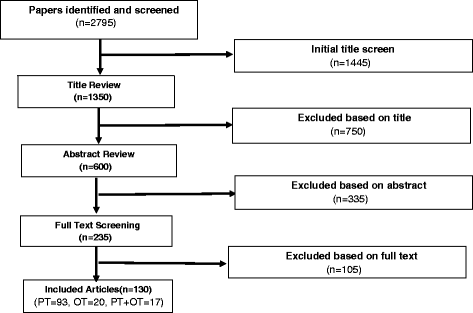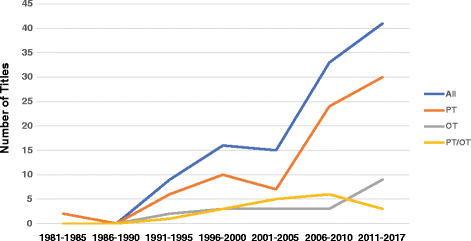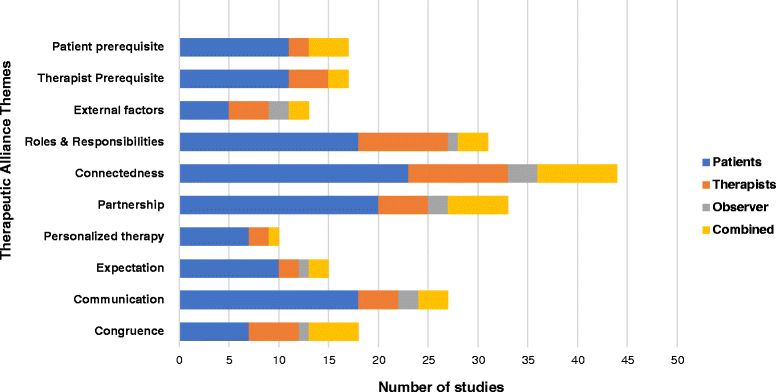Characteristics of therapeutic alliance in musculoskeletal physiotherapy and occupational therapy practice: a scoping review of the literature
- PMID: 28558746
- PMCID: PMC5450083
- DOI: 10.1186/s12913-017-2311-3
Characteristics of therapeutic alliance in musculoskeletal physiotherapy and occupational therapy practice: a scoping review of the literature
Erratum in
-
Correction to: Characteristics of therapeutic alliance in musculoskeletal physiotherapy and occupational therapy practice: a scoping review of the literature.BMC Health Serv Res. 2017 Dec 12;17(1):820. doi: 10.1186/s12913-017-2776-0. BMC Health Serv Res. 2017. PMID: 29233138 Free PMC article.
Abstract
Background: Most conventional treatment for musculoskeletal conditions continue to show moderate effects, prompting calls for ways to increase effectiveness, including drawing from strategies used across other health conditions. Therapeutic alliance refers to the relational processes at play in treatment which can act in combination or independently of specific interventions. Current evidence guiding the use of therapeutic alliance in health care arises largely from psychotherapy and medicine literature. The objective of this review was to map out the available literature on therapeutic alliance conceptual frameworks, themes, measures and determinants in musculoskeletal rehabilitation across physiotherapy and occupational therapy disciplines.
Methods: A scoping review of the literature published in English since inception to July 2015 was conducted using Medline, EMBASE, PsychINFO, PEDro, SportDISCUS, AMED, OTSeeker, AMED and the grey literature. A key search term strategy was employed using "physiotherapy", "occupational therapy", "therapeutic alliance", and "musculoskeletal" to identify relevant studies. All searches were performed between December 2014 and July 2015 with an updated search on January 2017. Two investigators screened article title, abstract and full text review for articles meeting the inclusion criteria and extracted therapeutic alliance data and details of each study.
Results: One hundred and thirty articles met the inclusion criteria including quantitative (33%), qualitative (39%), mixed methods (7%) and reviews and discussions (23%) and most data came from the USA (23%). Randomized trials and systematic reviews were 4.6 and 2.3% respectively. Low back pain condition (22%) and primary care (30.7%) were the most reported condition and setting respectively. One theory, 9 frameworks, 26 models, 8 themes and 42 subthemes of therapeutic alliance were identified. Twenty-six measures were identified; the Working Alliance Inventory (WAI) was the most utilized measure (13%). Most of the therapeutic alliance themes extracted were from patient perspectives. The relationship between adherence and therapeutic alliance was examined by 26 articles of which 57% showed some correlation between therapeutic alliance and adherence. Age moderated the relationship between therapeutic alliance and adherence with younger individuals and an autonomy support environment reporting improved adherence. Prioritized goals, autonomy support and motivation were facilitators of therapeutic alliance.
Conclusion: Therapeutic Alliance has been studied in a limited extent in the rehabilitation literature with conflicting frameworks and findings. Potential benefits described for enhancing therapeutic alliance might include better exercise adherence. Several knowledge gaps have been identified with a potential for generating future research priorities for therapeutic alliance in musculoskeletal rehabilitation.
Keywords: Musculoskeletal; Occupational therapy; Physiotherapy; Service delivery; Therapeutic alliance.
Figures
References
-
- Menta R, Randhawa K, Cote P, Wong JJ, Yu H, Sutton D, Varatharajan S, et al. The effectiveness of exercise for the management of musculoskeletal disorders and injuries of the elbow, forearm, wrist and hand: a systematic review by the Ontario protocol for traffic injury management (OPTIMA) collaboration. J Manip Physiol Therap. 2015;38:507–520. doi: 10.1016/j.jmpt.2015.06.002. - DOI - PubMed
-
- Cole MB, McLean V. Therapeutic relationship re-defined. Occup Ther Mental Health. 2003;19:33–56. doi: 10.1300/J004v19n02_03. - DOI
Publication types
MeSH terms
Grants and funding
LinkOut - more resources
Full Text Sources
Other Literature Sources
Miscellaneous




